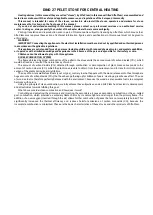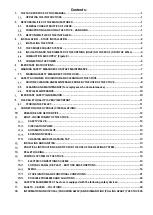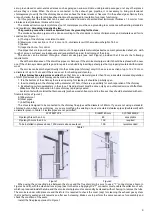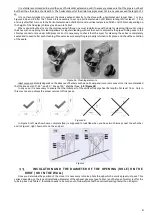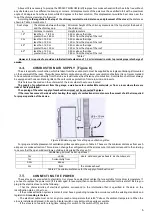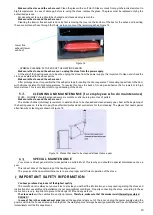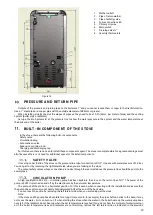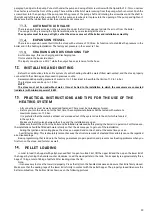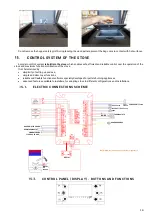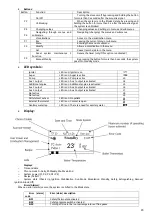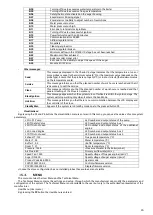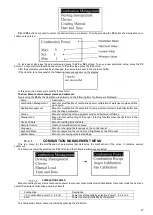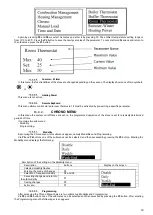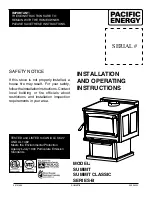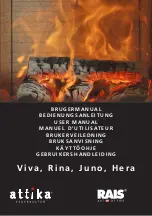
6
Above all it is necessary to provide the PERFECT AIRFLOW (draft) in pipes for smoke exhaustion that has to be free, without
any obstacles, such as different narrowing or corners. All displacements of the axis must have a tilted orbit with a maximum
angle of 45 degrees from the vertical, while 30 degrees is the best solution. This displacement would be best done near the
top of the chimney resistant to the wind.
According to the regulations (the top of the chimney resistant to wind, distance, and placement of the stove) the distances
shown in Table 3 must be met:
Roof slope:
The distance between the ridge
and the chimney cap
Minimum height of the chimney measured at the top slot (at the back of
the chimney)
α
Distance in meters
Height in meters
15
0
less than 1.85 m
greater than 1.85 m
0,50 m above the ridge
1,00 m from the slope of the roof
30
0
less than 1.50 m
less than 1.50 m
0,50 m above the ridge
1,30 m from the slope of the roof
45
0
less than 1.30 m
greater than 1.30 m
0,50 m above the ridge
2,00 m from the slope of the roof
60
0
less than 1.20 m
greater than 1.20 m
0,50 m above the ridge
2,60 m from the slope of the roof
Table 3
However, it is required to provide an initial vertical extension of 1,5 m (minimum) in order to provide proper discharge of
smoke.
COMBUSTION AIR SUPPLY (Figure 8)
The air required for combustion, which is taken from the environment, must be supplied by a single ventilation grill mounted
on the outer wall of the room. This will ensure better combustion and thus lower consumption of pellets. It is not recommended
to have outside air drawn directly from the tube, as it will reduce the efficiency of combustion. A ventilation shaft must always
be equipped with one ventilation grille on the outer side as protection from rain, wind, and insects.
This hole must be made on the outer wall of the room where the stove is located.
The supply of combustion air from the garage, a warehouse for combustible materials, or from a room where there are
risks of fire is prohibited.
The opening of the outer supply of combustion air must not be connected by pipes.
If the room has some other devices for heating, the supply of combustion air must ensure the amount of air that is required
for proper operation of the device.
Figure 8: Minimum gaps for setting up ventilation grilles.
For proper and safe placement of ventilation grilles see data given in Table 4. These are the minimum distances from each
airspace or smoke extraction. This value can change the configuration of the air pressure. It should correspond to the ordering
to secure that the open window draws outside air, depriving the stove of it.
Ventilation grid must be set up at least
1 m
under
doors, windows, gas exhausts, air chambers, etc.
1 m
horizontally from
0.3 m
above
2 m
from
the smoke exhaust
Table 4: The minimum distance for the supply of combustion air
CONNECTING THE POWER
These stoves are connected to electricity. Our stoves have electrical cables that are suitable for medium temperature. If
you need to replace the power cord (if it is damaged, for example) then consult with our authorized technical staff. Before you
plug in the electric stove note the following:
- That the characteristics of electrical systems correspond to the information that is specified in the data on the
identification plate on the stove.
- If the smoke extraction system is metal, it must have a grounding terminal in accordance with the existing standards and
legislation. Grounding is the law.
- The electrical cable must not at any time reach a temperature that is 80
0
C above the ambient temperature. When the
stove is installed and placed in its spot, a bipolar switch or socket must be easily accessible.
- If the stove is not used for a long time, unplug it or switch to the switch off (0) position.


